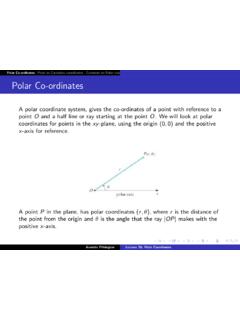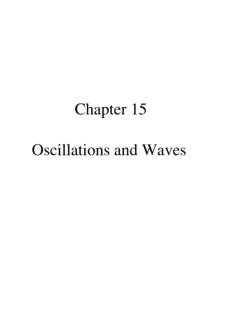Transcription of Lecture L20 - Energy Methods: Lagrange’s
1 S. Widnall Dynamics Fall 2009 Version Lecture L20 - Energy Methods: Lagrange s Equations The motion of particles and rigid bodies is governed by Newton s law. In this section, we will derive an alternate approach, placing Newton s law into a form particularly convenient for multiple degree of freedom systems or systems in complex coordinate systems . This approach results in a set of equations called Lagrange s equations. They are the beginning of a complex, more mathematical approach to mechanics called analytical dynamics. In this course we will only deal with this method at an elementary level.
2 Even at this simplified level, it is clear that considerable simplification occurs in deriving the equations of motion for complex systems. These two approaches Newton s Law and Lagrange s Equations are totally compatible. No new physical laws result for one approach vs. the other. Many have argued that Lagrange s Equations, based upon conservation of Energy , are a more fundamental statement of the laws governing the motion of particles and rigid bodies. We shall not enter into this debate. Derivation of Lagrange s Equations in Cartesian coordinates We begin by considering the conservation equations for a large number (N) of particles in a conservative force field using cartesian coordinates of position xi.
3 For this system , we write the total kinetic Energy as M 1 2T = mix (1)2 i . n=1 where M is the number of degrees of freedom of the system . For particles traveling only in one direction, only one xi is required to define the position of each particle, so that the number of degrees of freedom M = N. For particles traveling in three dimensions, each particle requires 3 xi coordinates , so that M = 3 N. The momentum of a given particle in a given direction can be obtained by differentiating this expression with respect to the appropriate xi coordinate. This gives the momentum pi for this particular particle in this coordinate direction.
4 T = pi (2) x i The time derivative of the momentum is d T = mix i (3)dt x i 1 For a conservative force field, the force on a particle is given by the derivative of the potential at the particle position in the desired direction. V Fi = xi (4) From Newton s law we have Fi = dpi (5)dt Equating like terms from our manipulations on kinetic Energy and the potential of a conservative force field, we write d T V dt x i = xi (6) Now we make use of the fact that T = 0 (7) xi and V = 0 (8) x i Using these results, we can rewrite Equation (6) as dtd (T x i V ) (T x i V ) = 0 (9) We now define L = T V : L is called the Lagrangian.
5 Equation (9) takes the final form: Lagrange s equations in cartesian coordinates . d L L dt x i xi = 0 (10) where i is taken over all of the degrees of freedom of the system . Before moving on to more general coordinate systems , we will look at the application of Equation(10) to some simple systems. Mass-spring system We first consider a simple mass spring system . This is a one degree of freedom system , with one xi. Its kinetic Energy is T = 1/2mx 2; its potential is V = 1/2kx2; its Lagrangian is L = 1/2mx 2 1/2kx2. Applying Equation (10) to the Lagrangian of this simple system , we obtain the familiar differential equation for the mass-spring oscillator.
6 D2x m + kx = 0 (11)dt2 Clearly, we would not go through a process of such complexity to derive this simple equation. However, let s consider a more complex system , governed by the same laws. 2 This is a 2 degree of freedom system , governed by 2 differential equations. The number of springs for this configuration is 3. These governing equations could be obtained by applying Newton s Law to the force balance that exists at each mass due to the deflection of the springs as was done in Lecture 19. The deflection of springs 1 and 3 are influenced by the boundary condition at either end of the slot; in this case the deflection is zero.
7 The governing equations can also be obtained by direct application of Lagrange s Equation. This approach is quite straightforward. The expression for kinetic Energy is 2 1 T = mix 2; (12) 2 i n=1 the expression for the potential is V = 1/2k1x 2 + 1/2k2(x2 x1)2 + 1/2k3x 2 (13)12 Applying Lagrange s equation to T V = L d dt L x1 L x1 = 0 (14) d dt L x2 L x2 = 0 (15) we obtain the governing equations as d2x1 m1 = k1x1 + k2(x2 x1) (16)dt2 m2 d2x2 = k2(x2 x1) k3x2 (17)dt2 Clearly, for multi degree of freedom systems, this approach has advantages over the force balancing approach using Newton s law.
8 Extension to General coordinate systems A significant advantage of the Lagrangian approach to developing equations of motion for complex systems comes as we leave the cartesian xi coordinate system and move into a general coordinate system . An 3 example would be polar coordinates where for a two-dimensional position of a mass particle, x1 and x2 could be given by r and . A two-degree of freedom system remains two-degree so that the number of coordinate variables required remains two. r and and their counterparts in other coordinate systems will be referred to as generalized coordinates .
9 We introduce quite general notation for the relationship between the n cartesian variables of position xi and their description in generalized coordinates . (For some systems, the number of generalized coordinates is larger than the number of degrees of freedom and this is accounted for by introducing constraints on the system . This is an important part of the discussion of the Lagrange formulation. We shall not however develop these relations but will work directly with the number of variables equal to the number of degrees of freedom of the system .) We express the cartesian variable xi using generalized coordinates qj.
10 ( polar coordinates r, would be an example.) xi = xi(q1, ..qj , ..qn). (18) In the general case, each xi could be dependent upon every qj . What is remarkable about the Lagrange formulation, is that (10) holds in a general coordinate system with xi replaced by qi. d L L dt q i qi = 0 (19) Before showing how this result can be derived from Newton s Law, we show two applications in polar coordinates to demonstrate the power of the approach. Simple Pendulum by Lagrange s Equations We first apply Lagrange s equation to derive the equations of motion of a simple pendulum in polar coor dinates.

















